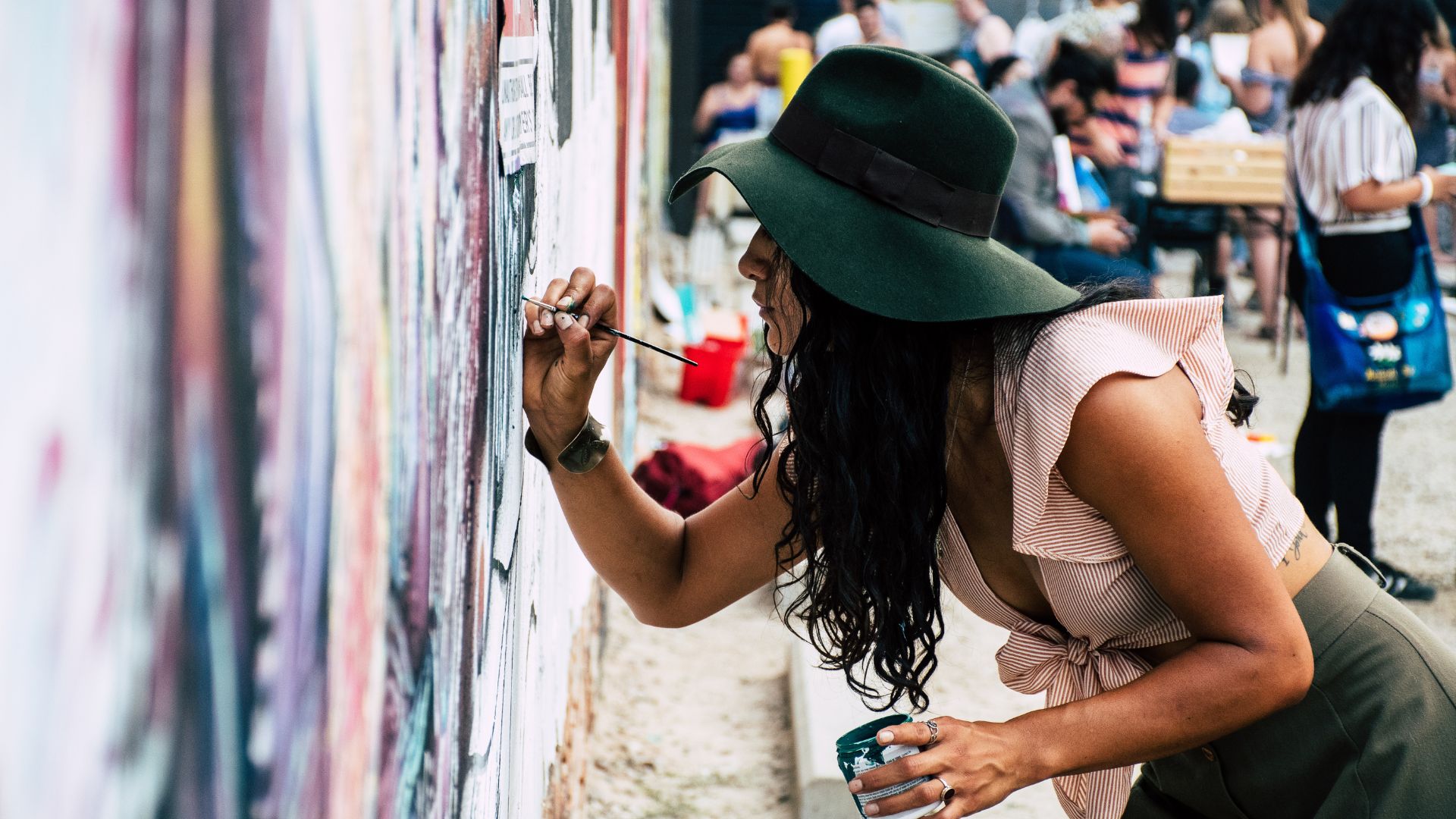Premium Spanish Lessons for the Modern Learner

Getting Creative: Using Art To Improve Your Spanish Skills
¡Hola amigos! Are you struggling to improve your Spanish skills? Perhaps you have tried traditional methods such as memorization and grammar drills, but still find yourself lacking in confidence when it comes to speaking and understanding the language.
Fear not, for there is a creative solution that may just be the missing piece of the puzzle: art.
Art can be an incredibly effective tool for improving your Spanish skills. By incorporating visual elements into your learning process, you engage different parts of your brain and make connections between words and their meanings that stick with you long after a lesson or study session has ended.
In this article, we will explore how using art can help you learn Spanish more effectively, and provide some practical tips for incorporating artistic techniques into your language practice routine.
So grab your sketchbook and let’s get creative!
The Benefits Of Using Art In Language Learning
Exploring museums and works of art is an excellent way to improve your Spanish language skills. Artistic expression is a means of acquiring new perspectives, specific vocabulary and deeper cultural understanding. In addition, the emotional connection you establish with art pieces helps you retain information more effectively.
By using art as a tool to learn Spanish, you are not only improving your language skills but also broadening your cultural horizons.
You can observe different periods and artistic movements while learning about the most influential Mexican or Spanish artists. You can even go further by reading their biographies or watching films based on their lives to get a full picture of the social and historical context behind their creations.
Incorporating Art Into Your Spanish Practice Routine
A recent study showed that using art to improve language skills can be an effective method. In particular, those who incorporated art practice into their daily language learning routine experienced significant improvement in listening and speaking comprehension.
With this valuable information in mind, it is time to explore how we can use art to improve our Spanish skills. One creative and interesting way to do this is through ‘Sketching Conversations’ or ‘Pintando Pronunciación’.
This technique involves drawing or painting while practicing your Spanish conversation. For example, you can choose a specific topic, such as describing your favorite hobbies, and then create a piece of artwork around that topic while you talk about it in Spanish.
In this way, you are improving both your language skills and your ability to express yourself visually.
Drawing Vocabulary Words And Phrases
To improve your Spanish skills, it is important that you learn and practice new words and phrases.
What better way to do this than through art? With simple drawing techniques, you can effectively incorporate new vocabulary into your linguistic repertoire.
Start by selecting a Spanish word or phrase that you would like to learn. Then, use basic sketching techniques to visualize that word or phrase on paper. You can experiment with different colors and textures to add dimension and visual interest to your design.
By creating this type of work, you are not only expanding your knowledge of the language but also exercising your artistic creativity. Don’t be afraid to make mistakes! Constant practice is the key to perfecting both your language and artistic skills.
Now that you have some ideas on how to use drawing to improve your Spanish, read on to find out how you can take this to the next level by creating art projects entirely in Spanish.
Creating Spanish-Language Art Projects
Imagine you are in an art gallery, surrounded by vibrant artwork created by Spanish-speaking artists. Each piece tells a unique and exciting story that transports you to a new world full of Spanish language and culture. Wouldn’t it be amazing if you could create your own artwork to improve your Spanish language skills? Of course it would!
So here are some creative ideas for bilingual art projects.
- Collaborative murals: Imagine working hand-in-hand with other students or friends to create a giant mural filled with bright colors and inspirational phrases in English and Spanish. Each person can contribute their own style and creativity while learning new words and expressions from the other language.
- Crafting bilingual comics: If you are a comic book fan, you could try making your own drawings using both languages in the narrative. This way, you can practice grammar and vocabulary while creating fun and exciting characters.
- Multilingual poetry: Poetry is another wonderful way to combine art and language. Try writing short poems using key words in both English and Spanish to experiment with different rhythms and tones.
As an expert in the intersection of art and language, I can tell you without a doubt that these projects are excellent ways to improve your understanding of Spanish while exercising your artistic creativity. Plus, there’s nothing more satisfying than seeing your own work on public display or shared with close friends. So, let’s get to work! Get started now on your path to full and exciting bilingual proficiency.
In the next section, we’ll explore more ideas on how to use the visual arts to learn about Spanish language and culture.
Exploring Spanish Art And Culture As A Language Learning Tool
Continuing our exploration of using art to improve your Spanish skills, let’s shift our focus to exploring Spanish art and culture as a language learning tool. Visiting museums is an excellent way to immerse yourself in the language and learn about the history and cultural significance behind various works of art. By reading labels and listening to audio guides, you can practice your comprehension while expanding your vocabulary with specialized terms related to art.
Watching Spanish language films is another fun way to engage with the language while immersing yourself in the rich culture of Spain and Latin America. Pay attention to idiomatic expressions and regional accents that may differ from what you’re used to hearing. You’ll also gain insight into contemporary issues facing Spanish-speaking communities around the world, which will help deepen your understanding of their perspectives on society, politics, and more.
| Art Form | Description | Benefits |
|---|---|---|
| Painting | Examining famous Spanish painters’ works like Pablo Picasso or Salvador Dalí | Understanding symbolism in paintings; Learning new vocabulary words specific for painting |
| Music | Listening to popular music genres such as flamenco or reggaeton | Practice differentiating between sounds; Learn popular phrases used in songs |
| Dance | Taking dance lessons like salsa or tango | Improve listening skills through following directions given by instructor; Experience physical expression of emotions |
Incorporating these activities into your daily routine will not only make learning Spanish more enjoyable but also provide opportunities for deeper connections with Hispanic cultures worldwide. So go ahead, explore museums near you, watch some movies online, take a dance class – there’s no limit to how creative you can get when it comes to incorporating art into your language-learning journey!
Frequently Asked Questions
What Type Of Art Is Best For Improving Spanish Skills?
When seeking to improve your Spanish skills through art, it’s important to consider which type of art form will be most effective.
Collaborative projects are a great option as they allow for interaction with others who speak the language fluently and can provide guidance on pronunciation and vocabulary usage.
Cultural immersion through art is also highly recommended as it provides an opportunity to gain insight into the customs and traditions of native Spanish speakers.
Like a brushstroke on canvas, finding the perfect balance between these two approaches can create a rhythm and flow in your language learning journey that feels natural and engaging.
As a Spanish language and art creative writing expert, I believe that incorporating both collaborative projects and cultural immersion into your artistic pursuits can yield incredible results in improving your Spanish proficiency while simultaneously igniting a passion for creativity.
Can Art Really Help Me Improve My Spanish Pronunciation?
Art vs. Language Learning: Which is more effective?
As a Spanish language and art creative writing expert, I am frequently asked if art can be used to improve fluency in other languages. The answer is yes!
In fact, using art as a tool for language learning has become increasingly popular among educators and learners alike. When you engage with art, whether it’s through painting or music, you are actively training your brain to process information differently than when studying vocabulary words or grammar rules.
By incorporating visual cues and auditory stimulation into your language practice routine, you can enhance your pronunciation and overall fluency in Spanish without even realizing it.
So don’t underestimate the power of creativity – get inspired by some beautiful artwork while improving your Spanish skills at the same time!
Do I Need To Have Artistic Skills To Use Art As A Language Learning Tool?
Artistic expression and language acquisition go hand in hand like the color green does with nature.
You don’t need to be an expert in art, nor do you require perfect Spanish fluency to use art as a powerful tool for improving your linguistic skills.
Art is about being creative and spontaneous; it’s about expressing yourself through mediums that transcend words alone.
By using artistic methods such as painting or drawing, you can tap into different parts of your brain – unlocking new pathways for learning and retaining information while also having fun doing so!
Can Art Be Used To Improve My Spanish Writing Skills?
Art projects are an excellent way to improve your Spanish writing skills.
Through vocabulary building, you can learn new words and expressions while also developing your artistic abilities.
As a language and art creative writing expert, I recommend trying activities that incorporate both elements, such as creating a comic strip with dialogue in Spanish or painting scenes from a novel you’re reading.
These exercises not only enhance your language proficiency but also allow you to express yourself creatively and have fun while doing it.
So grab some paints, pens, or clay and start improving your Spanish today!
How Long Does It Typically Take To See Improvement In My Spanish Skills Through Art?
Measuring progress through art is an essential aspect of utilizing art as a language learning tool.
As a Spanish and art creative writing expert, I have found that improvement in one’s language skills varies depending on the individual’s dedication to their craft.
Some may notice improvements within weeks or months, while others may take longer.
However, it is important to remember that artistic expression allows for creativity and experimentation which can lead to more efficient learning methods.
Through consistent practice and self-reflection, you will be able to gauge your progress accurately.
Remember, patience and perseverance are key when using art as a means of improving your Spanish skills.
Conclusion
In conclusion, art can be a powerful tool to improve your Spanish skills. Whether it’s through drawing, painting, or even crafting, engaging in creative activities that require you to use Spanish vocabulary and grammar can help you internalize the language more effectively.
However, don’t expect overnight results. Learning a language is a gradual process that takes time and patience. But with regular practice and dedication, incorporating art into your language learning routine can not only make the experience more enjoyable but also accelerate your progress.
As an expert in both Spanish language and art, I encourage you to embrace creativity as a means of improving your proficiency in this beautiful language.
Remember that every brushstroke or sketch is an opportunity to immerse yourself in the rich culture of Spain while sharpening your linguistic abilities. ¡Buena suerte y diviértete creando! (Good luck and have fun creating!)







